‘Great Rotation’ Includes Safe Money Markets
The equity side of Wall Street coined the term great rotation to describe what they hoped would be a mass migration by investors from bonds to stocks. Many investors have not forgotten when the S&P 500 plunged 50%-plus (2007-2009). From the Wall Street Journal:
Investors are cashing out of bonds but remain hesitant to plunge into stocks, preferring instead to buy money-market mutual funds despite their low returns. The surprise move highlights persistent investor anxiety with equities even as stock indexes reach new highs. Investors withdrew an estimated $43 billion from taxable bond mutual funds last month, the largest-ever monthly outflow, according to the Investment Company Institute. The debt-market swoon was fueled by worries that the Federal Reserve was softening its commitment to keeping interest rates low. Rising interest rates mean lower bond prices.
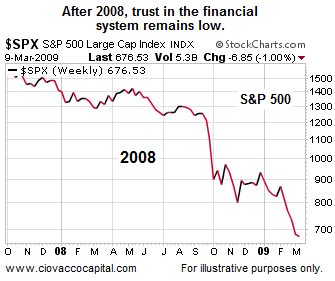 The Market Has Spoken
The Market Has Spoken
If the proof is in the pudding and price does not lie, then the chart below shows stocks are the place to be relative to bonds. When the ratio of bonds (AGG) vs. stocks (SPY) rises, it tells us the demand for bonds is greater than the demand for stocks. Conversely, when the ratio falls, it shows greater demand for stocks relative to bonds. The ratio has been in a weekly downtrend, favoring stocks, for all of 2013.
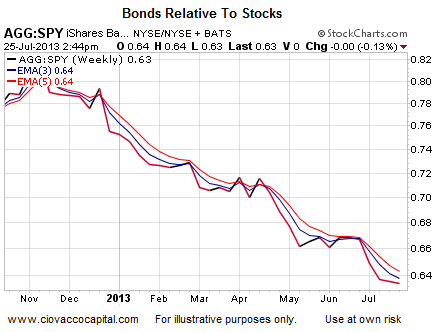 Our market model, which uses numerous inputs including the bond/stock chart above, is clearly favoring stocks over bonds. You would think the liquidation of bond funds would lead to the anticipated great rotation into stocks. In the words of ESPN’s Lee Corso, “Not So Fast My Friend”.
Our market model, which uses numerous inputs including the bond/stock chart above, is clearly favoring stocks over bonds. You would think the liquidation of bond funds would lead to the anticipated great rotation into stocks. In the words of ESPN’s Lee Corso, “Not So Fast My Friend”.
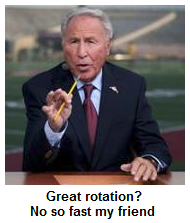 The Wall Street Journal pours some cold water on the equity crowd hoping to gather the bond assets:
The Wall Street Journal pours some cold water on the equity crowd hoping to gather the bond assets:
Many observers expected to see those flows turn to funds tracking U.S. stocks. But in a twist, the main beneficiary of the rush out of bonds has been money-market funds, which are cash-like investments that appeal to safety-minded investors. Assets in these portfolios increased for the fourth week in a row in the week ended July 17, rising $8.5 billion to $2.6 trillion, ICI data show.
Gun-Shy For Good Reason
Investors have solid evidence to be gun-shy in the wake of the global financial crisis. Will another ugly 50%-plus bear market rear its ugly head in the future? Yes, it is not a question of if, but when. History is littered with painful bear markets. The question is one of timing. The current bull could last two or three more years…maybe longer.
2008: Problems Were ‘Contained’
Since things can fall apart quickly in a world heavily impacted by central bankers and printed money, it is essential to have the tools in place to monitor the market’s risk appetite. The charts and economic data seem to indicate “everything is fine” right now, but history tells us that things can change quickly. Below is a quote from Ben Bernanke on March 28, 2007 when the S&P 500 was trading at 1417:
“At this juncture, however, the impact on the broader economy and financial markets of the problems in the subprime market seems likely to be contained. In particular, mortgages to prime borrowers and fixed-rate mortgages to all classes of borrowers continue to perform well, with low rates of delinquency.”
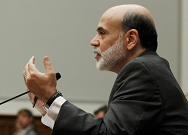 From 1417, the S&P 500 eventually dropped to an intraday low of 666 on March 6, 2009. Stocks lost 53% despite the problems in subprime being contained.
From 1417, the S&P 500 eventually dropped to an intraday low of 666 on March 6, 2009. Stocks lost 53% despite the problems in subprime being contained.
A Way To Protect Ourselves
Was it possible to see something was changing after stocks peaked in October 2007? Yes, there were many ways to monitor the shift from risk-on to risk-off, including the bond vs. stock chart we reviewed earlier. The chart below shows the AGG vs. SPY ratio on top with the S&P 500 below. In mid-June 2008, with the S&P 500 trading at 1360, the weekly trend clearly shifted in favor of bonds over stocks.
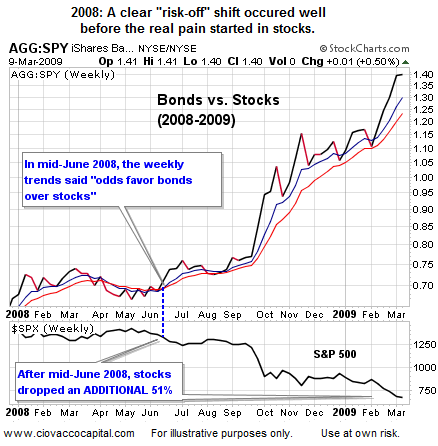 Pay Attention And Market Will Guide Us
Pay Attention And Market Will Guide Us
You can see why charts like the one above can be very helpful. One of the most important lessons in the markets is that many things “work”, but the key is having a disciplined and consistent system in place to monitor what works and knowing how to translate signals into real-world action. As we have noted since late June, the market is saying “risk-on”. How long will that last? No one knows, but it doesn’t matter if we pay attention with an open mind and make changes as conditions shift to “risk-off”.
Thus Far – Volatility To Ignore
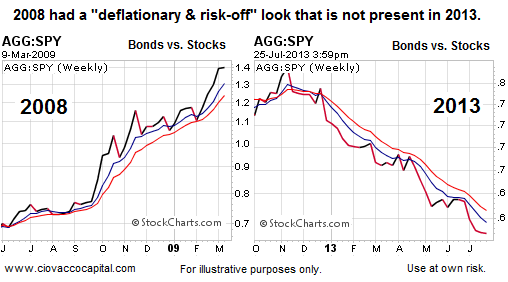 How was the AGG vs. SPY chart helpful in 2008? It helped discern between volatility to ignore and volatility that required a shift from stocks to bonds. So far, the charts and our model are placing the recent choppiness in stocks into the “volatility to ignore” category. As long as that is the case and the economic data allows, we will try to give our U.S.-related ETFs some room to continue running. Our core positions are in the broad market (VTI), financials (XLF), and technology (QQQ).
How was the AGG vs. SPY chart helpful in 2008? It helped discern between volatility to ignore and volatility that required a shift from stocks to bonds. So far, the charts and our model are placing the recent choppiness in stocks into the “volatility to ignore” category. As long as that is the case and the economic data allows, we will try to give our U.S.-related ETFs some room to continue running. Our core positions are in the broad market (VTI), financials (XLF), and technology (QQQ).
Speak Your Mind